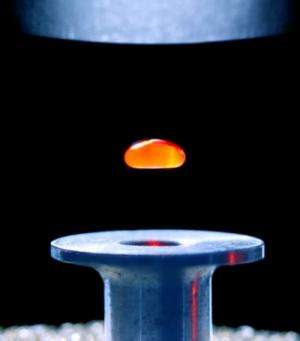In medicine, the future is light

Light, together with artificial intelligence systems that deliver fast, accurate analysis, has the potential to reshape the diagnosis and treatment of disease.
Dr Bayden Wood, of Monash University's School of Chemistry, is focusing on new ways to detect and analyse malaria, heart disease and cancer. The significance of this major project has been recognised by the Australian Research Council, which has awarded Dr Wood a Future Fellowship to support his work.
"It's all based on using light as a diagnostic tool in medicine," Dr Wood said.
"It combines cutting-edge technology and very high-powered computing systems. The diagnosis ultimately is made by a machine, so it is non-subjective."
Working with national and international collaborators, he is developing the use of infrared and laser light, and state-of-the-art spectroscopic instrumentation including the infrared beamline at the Australian Synchrotron, to detect the early presence of disease.
Malaria, for example, can be detected in blood at the initial stages of the parasite's life cycle by the way it scatters light.
Dr Wood wants to use only tiny amounts of blood for analysis and is investigating ways of using acoustic levitation to hold red blood cells in space as they are analysed by laser. This sci-fi-sounding approach has the very practical benefit of providing a container-less environment in which lasers have access to the entire cell, with potential going beyond malaria diagnosis.
Another approach, this time reminiscent of Dr McCoy's tricorder in Star Trek, would involve passing a hand-held spectrometer over someone's skin.
"We would essentially be using light to go through the skin to diagnose the parasites," Dr Wood said.
By eliminating the need for blood samples, this would make diagnosing children easier, and reduce risks for health workers in areas with high rates of AIDS.
Such an approach could not be used for most cancers or heart disease, where tissue samples would be needed. But spectroscopy still offers many potential advantages: it is so sensitive to chemical cell changes that it can detect the cell changes that precede visible indications of cancer, allowing for earlier diagnosis. Greater accuracy in grading tumours and establishing surgical boundaries is another possibility with technology that gives resolution at the single-cell level.
Light also has potential use in determining the status of atherosclerotic plaques in valves and arteries, providing better information about when to operate on heart-disease patients.
Developing the complex algorithms and huge databases necessary for high-powered artificial intelligence systems that can recognise the spectral patterns indicating disease is another part of Dr Wood's research.
Results would be fed into the system for accurate analysis that would avoid such problems as human fatigue.
The network is being designed to improve with time.
"New data adds to the previous data so the system is self-evolving," Dr Wood said.
"It is all high-speed, rapid automated diagnosis that is removed from human subjectivity, and can be done anywhere in the world."
Commercialisation of his ideas depends on further research, and clinical studies.

















